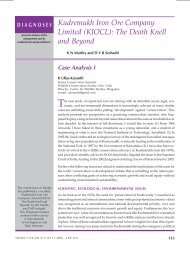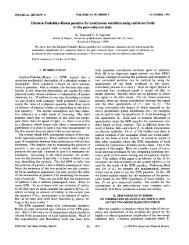Phase Transfer Catalysis - Publications of the IAS Fellows
Phase Transfer Catalysis - Publications of the IAS Fellows
Phase Transfer Catalysis - Publications of the IAS Fellows
You also want an ePaper? Increase the reach of your titles
YUMPU automatically turns print PDFs into web optimized ePapers that Google loves.
Microwaves<br />
Microphases<br />
Electra-organic syn<strong>the</strong>sis<br />
Photochemistry<br />
Metal co-catalyst<br />
Table 4. CombinaGons <strong>of</strong> PTC with O<strong>the</strong>r Rate Enhancement Techniques<br />
Combination <strong>of</strong> PTC with Illustrative Example Reference<br />
Ultrasound<br />
Michael addition involving <strong>the</strong> addition <strong>of</strong><br />
chalcone to diethyl malonate in SLPTC mode.<br />
Syn<strong>the</strong>sis <strong>of</strong> benzyl sulfide by reaction <strong>of</strong> solid<br />
sodium sulfide with benzyl chloride.<br />
Ratoarinoro et al. (1992)<br />
Contamine et al. (i994)’<br />
Hagenson et al. (1994)<br />
Esterifications, e<strong>the</strong>rification and hydrolysis<br />
<strong>of</strong> esters.<br />
Davidson et al. (1987)<br />
Michael reaction involving nitroalkanes with<br />
monosubstituted a, p-unsaturated esters.<br />
Jouglet et al. (1991)<br />
N-alkylation <strong>of</strong> indenese, N-N-diazocoronands,<br />
and amines.<br />
Galin et al. (1987)<br />
Syn<strong>the</strong>sis <strong>of</strong> fulvenese from phenylacetylene.<br />
Wang and Zhao (1996)<br />
Alkylation <strong>of</strong> ethylphenyl sulfonyl acetate, diethyl<br />
malonate, anions derived from active methylene.<br />
Dihalocyclopropanation <strong>of</strong> substituted olefins<br />
under LLPTC and SLPTC conditions.<br />
Ethoxylation <strong>of</strong> o,p-nitrochlorobenzene.<br />
Base catalyzed (soluble base, solid KzCOj or bases<br />
impregnated on alumina) syn<strong>the</strong>sis <strong>of</strong> esters.<br />
Reaction <strong>of</strong> carboqlic acids with halides.<br />
Syn<strong>the</strong>sis <strong>of</strong> benzyl sulfide by reaction <strong>of</strong> solid<br />
sodium sulfide with benzyl chloride.<br />
Chlorination <strong>of</strong> substituted naphthalenes.<br />
Toluene and aromatic hydrocarbon oxidation using<br />
Ce4 +/Ce3 + as a redox mediator.<br />
Anthracene oxidation to anthraquinone using<br />
Mn3’/Mn2 ’ as <strong>the</strong> redox mediator.<br />
Photocynation <strong>of</strong> aromatic hydrocarbons.<br />
Photochemically induced polymerization <strong>of</strong><br />
methyl methacrylate.<br />
Reduction <strong>of</strong> nitrobenzenes to <strong>the</strong><br />
corresponding oximes or quinones using viologens.<br />
PTC carbonylation <strong>of</strong> aryl and vinyl halides<br />
under UV irradiation.<br />
Photohydrogenation <strong>of</strong> acetylenic groups with<br />
viologen, Pt or Pd, and a photosensitizer.<br />
across <strong>the</strong> interface and ultrasound merely facilitates this<br />
transfer, possibly by increasing <strong>the</strong> interfacial area across<br />
which this transfer occurs. On <strong>the</strong> o<strong>the</strong>r hand, ultrasound by<br />
itself has been suggested as an alternative to PTC in a number<br />
<strong>of</strong> reactions (Regen and Singh, 1982; Mason et al., 1990).<br />
Ultrasound with basic alumina as a catalyst has been found<br />
to be a good substitute for PTC also (Ando et al., 1984;<br />
Hanasufa et al., 1987; Pradhan and Sharma, 1992).<br />
The use <strong>of</strong> ultrasound is found to alter <strong>the</strong> reaction pathway<br />
and selectivity ratio in some cases. For reactions where<br />
reagents may react ei<strong>the</strong>r by an ionic or a free radical pathway,<br />
ultrasound prefers <strong>the</strong> latter at <strong>the</strong> expense <strong>of</strong> <strong>the</strong> ionic<br />
pathway (Einhorn et al., 1990; Ando and Kimura, 1990: Luche<br />
et al., 1990). Neumann and Sasson (1985b) reported <strong>the</strong> use<br />
Cyclooligomerization <strong>of</strong> alkynes with RhC13<br />
as cocatalyst.<br />
Carbonylation reactions with Pd based<br />
complexes or cobalt carbonyl as cocatalyst.<br />
Hydrogenolysis <strong>of</strong> aryl bromides by aqueous<br />
sodium formate with Pd complex as cocatalyst.<br />
Selective hydrogenation <strong>of</strong> a,@-unsaturated<br />
carbonyl compounds using rhodium trichloride<br />
and Aliquat 336.<br />
Hydrogenolysis <strong>of</strong> bromoanisoles with sodium formate,<br />
Pd/C, and cyclodextrins as inverse Pt catalysts.<br />
Carbonylation <strong>of</strong> a-hydroxyalbes catalyzed by<br />
NiCN and a PT catalyst.<br />
Wang and Jiang (19921,<br />
Wang et al. (1995)<br />
Villemin and Labiad (1992)<br />
Yuan et al. (1992a)<br />
Loupy et al. (1993)<br />
Yuan et al. (1992b)<br />
Hagenson et al. (1994)<br />
Forsyth et al. (1987)<br />
Pletcher & Valdez (1988a,b)<br />
Chou et al. (1992)<br />
Beugelmans et al. (1978)<br />
Shimada et al. (1989,199O)<br />
Tomioka et al. (1986)<br />
Brunet et al. (1983)<br />
Maidan and Willner (1986)<br />
Amer et al. (1990)<br />
Alper (19881<br />
Bar et al. (1982)<br />
bran et al. (1986)<br />
Shimuzu et al. (1990)<br />
Arzoumanian et al. (1992)<br />
<strong>of</strong> ultrasound with PEG400 as <strong>the</strong> PT catalyst for <strong>the</strong> autooxidation<br />
<strong>of</strong> 4-nitrotoluene in <strong>the</strong> presence <strong>of</strong> oxygen and KOH.<br />
While mechanical agitation gave only <strong>the</strong> dimeric product,<br />
p-nitrobenzoic acid was obtained in <strong>the</strong> presence <strong>of</strong> ultrasonic<br />
irradiation. Contamine et al. (1994) found that in <strong>the</strong><br />
PT catalyzed Michael addition <strong>of</strong> chalcone on diethyl malonate<br />
in a solid-liquid system <strong>the</strong> reaction was activated not<br />
only through an increase in interfacial area, but also through<br />
<strong>the</strong> acceleration <strong>of</strong> a radical step. Thus, both mechanical and<br />
chemical effects can be seen in some PT catalyzed reactions.<br />
However, commercial feasibility <strong>of</strong> ultrasound depends on<br />
<strong>the</strong> development <strong>of</strong> novel reactors that can tap its great potential.<br />
Mason (1992) and Berlan and Mason (1992) describe<br />
several types <strong>of</strong> large-scale sonochemical reactors and ad-<br />
AIChE Journal March 1998 Vol. 44, No. 3 635
















